Applying NSQHS: Tuberculosis Precautions & Falls Prevention Strategies
VerifiedAdded on 2023/03/30
|6
|1162
|293
Report
AI Summary
This report addresses the critical aspects of managing tuberculosis and preventing falls within a healthcare setting, focusing on a case involving Mrs. Smith who has active tuberculosis. It begins by defining standard precautions and identifying relevant principles for Mrs. Smith's care, detailing the airborne mode of transmission for tuberculosis, and outlining appropriate transmission-based precautions like droplet and airborne precautions. The report emphasizes the importance of infection control standards in preventing the spread of tuberculosis within the hospital, protecting both patients and healthcare workers. It also explores the Comprehensive Care Standard from the National Safety and Quality Health Service (NSQHS) Standards, highlighting its role in ensuring comprehensive, coordinated care that minimizes patient harm through strategies addressing pressure injuries, patient falls, and poor nutrition. Furthermore, the report discusses two falls prevention strategies—governance and systems, and communicating with patients and carers—explaining how these strategies can be implemented to prevent further injury to Mrs. Smith by involving her in the development of a personalized falls prevention plan and continuously monitoring the system for effectiveness. This ensures a safer hospital environment and promotes better patient outcomes. Desklib provides access to similar solved assignments and resources for students.
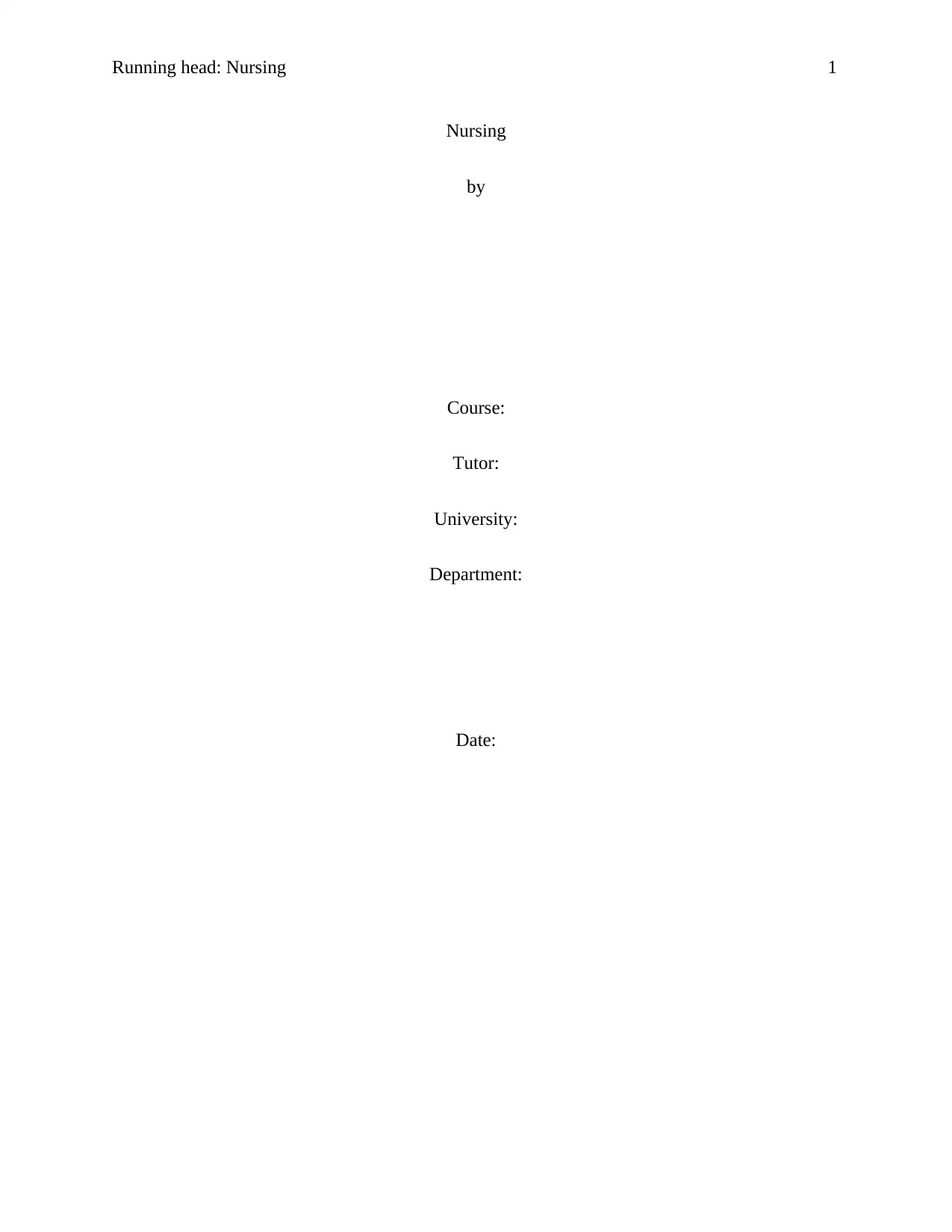
Running head: Nursing 1
Nursing
by
Course:
Tutor:
University:
Department:
Date:
Nursing
by
Course:
Tutor:
University:
Department:
Date:
Paraphrase This Document
Need a fresh take? Get an instant paraphrase of this document with our AI Paraphraser
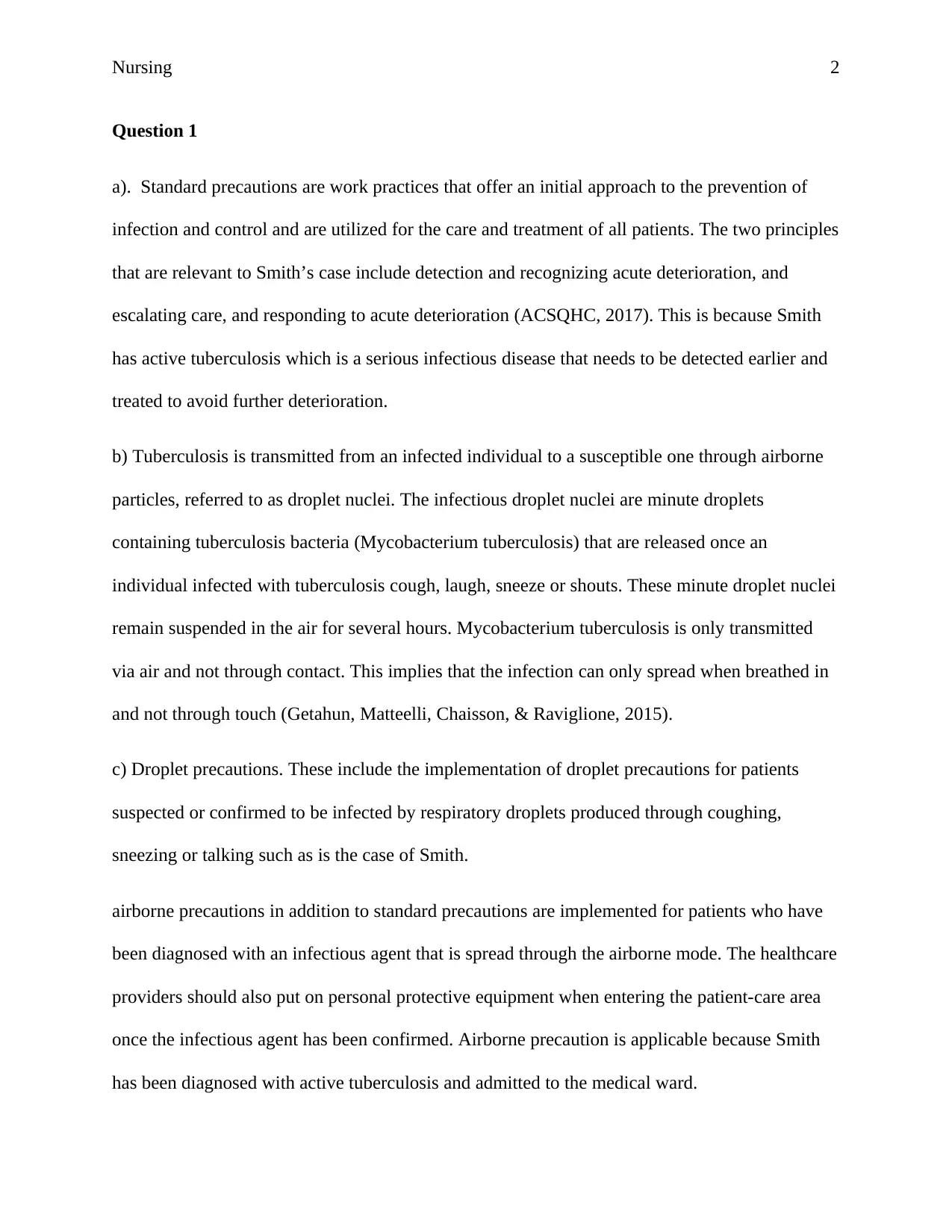
Nursing 2
Question 1
a). Standard precautions are work practices that offer an initial approach to the prevention of
infection and control and are utilized for the care and treatment of all patients. The two principles
that are relevant to Smith’s case include detection and recognizing acute deterioration, and
escalating care, and responding to acute deterioration (ACSQHC, 2017). This is because Smith
has active tuberculosis which is a serious infectious disease that needs to be detected earlier and
treated to avoid further deterioration.
b) Tuberculosis is transmitted from an infected individual to a susceptible one through airborne
particles, referred to as droplet nuclei. The infectious droplet nuclei are minute droplets
containing tuberculosis bacteria (Mycobacterium tuberculosis) that are released once an
individual infected with tuberculosis cough, laugh, sneeze or shouts. These minute droplet nuclei
remain suspended in the air for several hours. Mycobacterium tuberculosis is only transmitted
via air and not through contact. This implies that the infection can only spread when breathed in
and not through touch (Getahun, Matteelli, Chaisson, & Raviglione, 2015).
c) Droplet precautions. These include the implementation of droplet precautions for patients
suspected or confirmed to be infected by respiratory droplets produced through coughing,
sneezing or talking such as is the case of Smith.
airborne precautions in addition to standard precautions are implemented for patients who have
been diagnosed with an infectious agent that is spread through the airborne mode. The healthcare
providers should also put on personal protective equipment when entering the patient-care area
once the infectious agent has been confirmed. Airborne precaution is applicable because Smith
has been diagnosed with active tuberculosis and admitted to the medical ward.
Question 1
a). Standard precautions are work practices that offer an initial approach to the prevention of
infection and control and are utilized for the care and treatment of all patients. The two principles
that are relevant to Smith’s case include detection and recognizing acute deterioration, and
escalating care, and responding to acute deterioration (ACSQHC, 2017). This is because Smith
has active tuberculosis which is a serious infectious disease that needs to be detected earlier and
treated to avoid further deterioration.
b) Tuberculosis is transmitted from an infected individual to a susceptible one through airborne
particles, referred to as droplet nuclei. The infectious droplet nuclei are minute droplets
containing tuberculosis bacteria (Mycobacterium tuberculosis) that are released once an
individual infected with tuberculosis cough, laugh, sneeze or shouts. These minute droplet nuclei
remain suspended in the air for several hours. Mycobacterium tuberculosis is only transmitted
via air and not through contact. This implies that the infection can only spread when breathed in
and not through touch (Getahun, Matteelli, Chaisson, & Raviglione, 2015).
c) Droplet precautions. These include the implementation of droplet precautions for patients
suspected or confirmed to be infected by respiratory droplets produced through coughing,
sneezing or talking such as is the case of Smith.
airborne precautions in addition to standard precautions are implemented for patients who have
been diagnosed with an infectious agent that is spread through the airborne mode. The healthcare
providers should also put on personal protective equipment when entering the patient-care area
once the infectious agent has been confirmed. Airborne precaution is applicable because Smith
has been diagnosed with active tuberculosis and admitted to the medical ward.
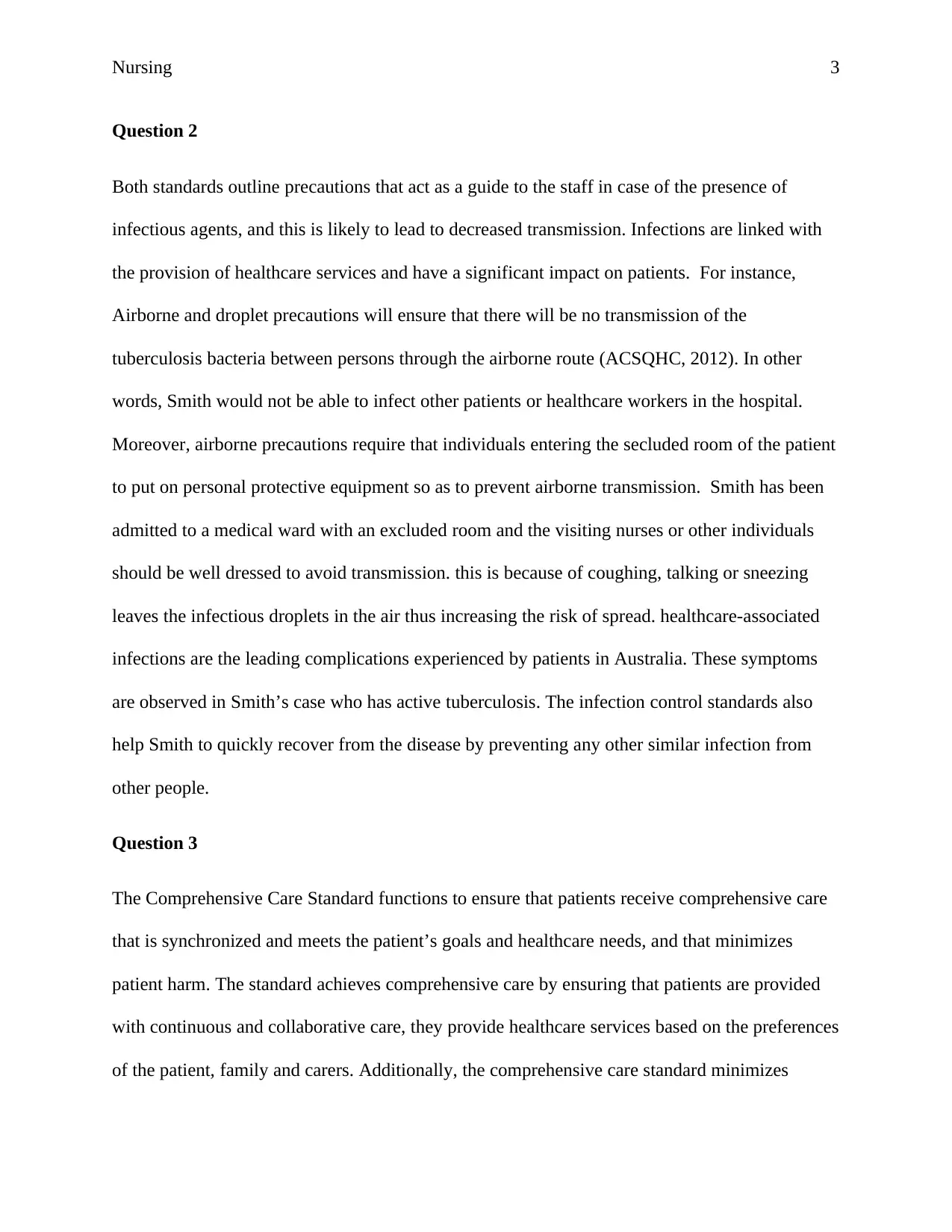
Nursing 3
Question 2
Both standards outline precautions that act as a guide to the staff in case of the presence of
infectious agents, and this is likely to lead to decreased transmission. Infections are linked with
the provision of healthcare services and have a significant impact on patients. For instance,
Airborne and droplet precautions will ensure that there will be no transmission of the
tuberculosis bacteria between persons through the airborne route (ACSQHC, 2012). In other
words, Smith would not be able to infect other patients or healthcare workers in the hospital.
Moreover, airborne precautions require that individuals entering the secluded room of the patient
to put on personal protective equipment so as to prevent airborne transmission. Smith has been
admitted to a medical ward with an excluded room and the visiting nurses or other individuals
should be well dressed to avoid transmission. this is because of coughing, talking or sneezing
leaves the infectious droplets in the air thus increasing the risk of spread. healthcare-associated
infections are the leading complications experienced by patients in Australia. These symptoms
are observed in Smith’s case who has active tuberculosis. The infection control standards also
help Smith to quickly recover from the disease by preventing any other similar infection from
other people.
Question 3
The Comprehensive Care Standard functions to ensure that patients receive comprehensive care
that is synchronized and meets the patient’s goals and healthcare needs, and that minimizes
patient harm. The standard achieves comprehensive care by ensuring that patients are provided
with continuous and collaborative care, they provide healthcare services based on the preferences
of the patient, family and carers. Additionally, the comprehensive care standard minimizes
Question 2
Both standards outline precautions that act as a guide to the staff in case of the presence of
infectious agents, and this is likely to lead to decreased transmission. Infections are linked with
the provision of healthcare services and have a significant impact on patients. For instance,
Airborne and droplet precautions will ensure that there will be no transmission of the
tuberculosis bacteria between persons through the airborne route (ACSQHC, 2012). In other
words, Smith would not be able to infect other patients or healthcare workers in the hospital.
Moreover, airborne precautions require that individuals entering the secluded room of the patient
to put on personal protective equipment so as to prevent airborne transmission. Smith has been
admitted to a medical ward with an excluded room and the visiting nurses or other individuals
should be well dressed to avoid transmission. this is because of coughing, talking or sneezing
leaves the infectious droplets in the air thus increasing the risk of spread. healthcare-associated
infections are the leading complications experienced by patients in Australia. These symptoms
are observed in Smith’s case who has active tuberculosis. The infection control standards also
help Smith to quickly recover from the disease by preventing any other similar infection from
other people.
Question 3
The Comprehensive Care Standard functions to ensure that patients receive comprehensive care
that is synchronized and meets the patient’s goals and healthcare needs, and that minimizes
patient harm. The standard achieves comprehensive care by ensuring that patients are provided
with continuous and collaborative care, they provide healthcare services based on the preferences
of the patient, family and carers. Additionally, the comprehensive care standard minimizes
⊘ This is a preview!⊘
Do you want full access?
Subscribe today to unlock all pages.

Trusted by 1+ million students worldwide
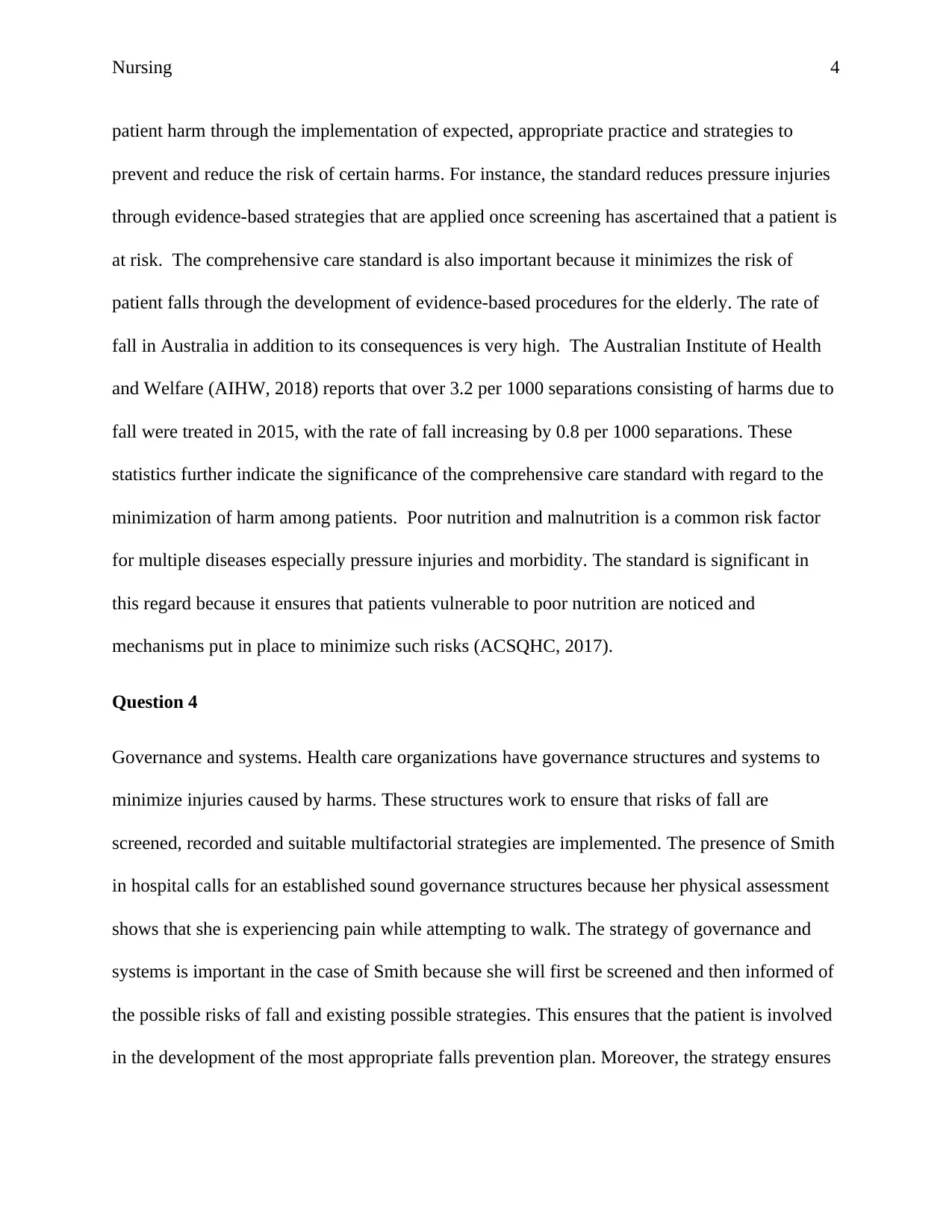
Nursing 4
patient harm through the implementation of expected, appropriate practice and strategies to
prevent and reduce the risk of certain harms. For instance, the standard reduces pressure injuries
through evidence-based strategies that are applied once screening has ascertained that a patient is
at risk. The comprehensive care standard is also important because it minimizes the risk of
patient falls through the development of evidence-based procedures for the elderly. The rate of
fall in Australia in addition to its consequences is very high. The Australian Institute of Health
and Welfare (AIHW, 2018) reports that over 3.2 per 1000 separations consisting of harms due to
fall were treated in 2015, with the rate of fall increasing by 0.8 per 1000 separations. These
statistics further indicate the significance of the comprehensive care standard with regard to the
minimization of harm among patients. Poor nutrition and malnutrition is a common risk factor
for multiple diseases especially pressure injuries and morbidity. The standard is significant in
this regard because it ensures that patients vulnerable to poor nutrition are noticed and
mechanisms put in place to minimize such risks (ACSQHC, 2017).
Question 4
Governance and systems. Health care organizations have governance structures and systems to
minimize injuries caused by harms. These structures work to ensure that risks of fall are
screened, recorded and suitable multifactorial strategies are implemented. The presence of Smith
in hospital calls for an established sound governance structures because her physical assessment
shows that she is experiencing pain while attempting to walk. The strategy of governance and
systems is important in the case of Smith because she will first be screened and then informed of
the possible risks of fall and existing possible strategies. This ensures that the patient is involved
in the development of the most appropriate falls prevention plan. Moreover, the strategy ensures
patient harm through the implementation of expected, appropriate practice and strategies to
prevent and reduce the risk of certain harms. For instance, the standard reduces pressure injuries
through evidence-based strategies that are applied once screening has ascertained that a patient is
at risk. The comprehensive care standard is also important because it minimizes the risk of
patient falls through the development of evidence-based procedures for the elderly. The rate of
fall in Australia in addition to its consequences is very high. The Australian Institute of Health
and Welfare (AIHW, 2018) reports that over 3.2 per 1000 separations consisting of harms due to
fall were treated in 2015, with the rate of fall increasing by 0.8 per 1000 separations. These
statistics further indicate the significance of the comprehensive care standard with regard to the
minimization of harm among patients. Poor nutrition and malnutrition is a common risk factor
for multiple diseases especially pressure injuries and morbidity. The standard is significant in
this regard because it ensures that patients vulnerable to poor nutrition are noticed and
mechanisms put in place to minimize such risks (ACSQHC, 2017).
Question 4
Governance and systems. Health care organizations have governance structures and systems to
minimize injuries caused by harms. These structures work to ensure that risks of fall are
screened, recorded and suitable multifactorial strategies are implemented. The presence of Smith
in hospital calls for an established sound governance structures because her physical assessment
shows that she is experiencing pain while attempting to walk. The strategy of governance and
systems is important in the case of Smith because she will first be screened and then informed of
the possible risks of fall and existing possible strategies. This ensures that the patient is involved
in the development of the most appropriate falls prevention plan. Moreover, the strategy ensures
Paraphrase This Document
Need a fresh take? Get an instant paraphrase of this document with our AI Paraphraser
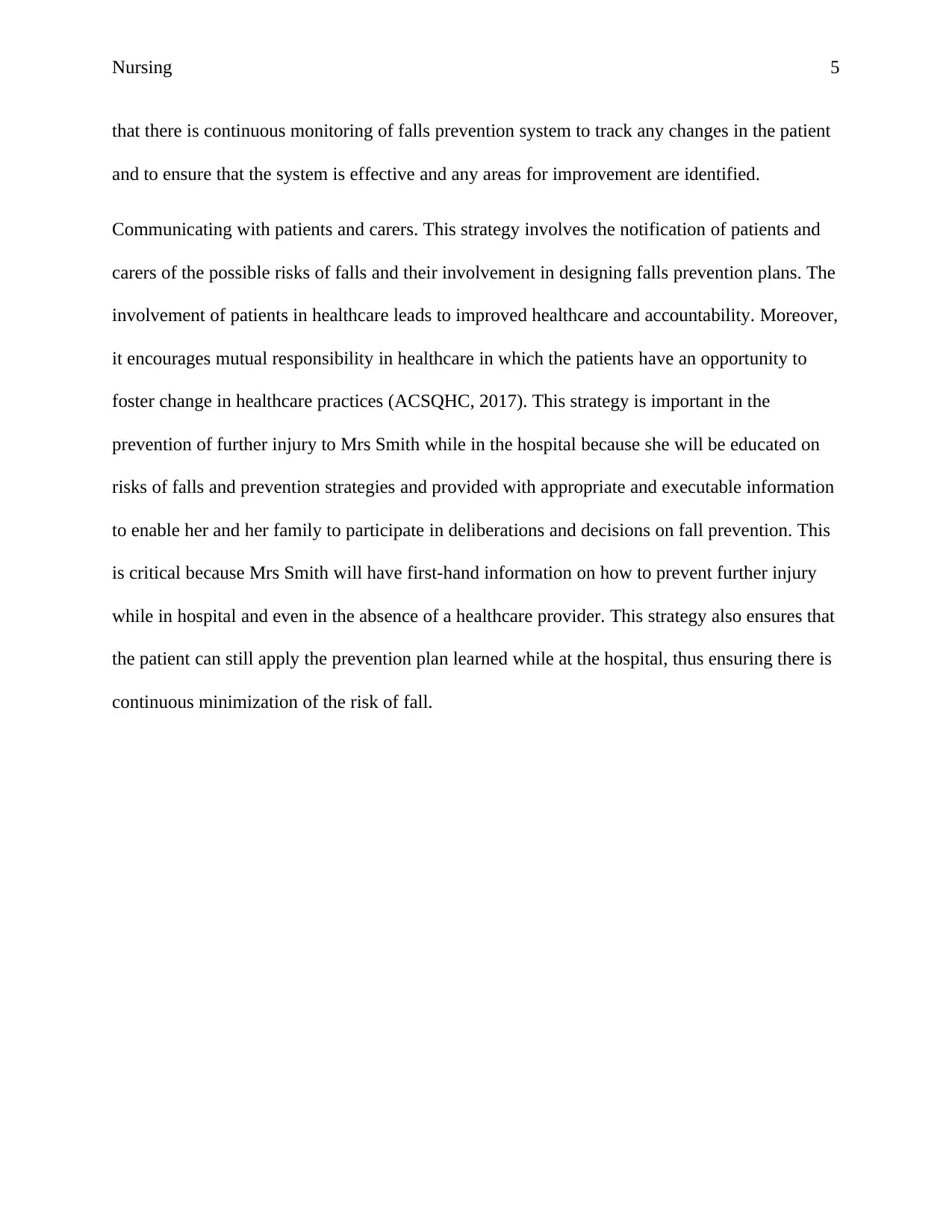
Nursing 5
that there is continuous monitoring of falls prevention system to track any changes in the patient
and to ensure that the system is effective and any areas for improvement are identified.
Communicating with patients and carers. This strategy involves the notification of patients and
carers of the possible risks of falls and their involvement in designing falls prevention plans. The
involvement of patients in healthcare leads to improved healthcare and accountability. Moreover,
it encourages mutual responsibility in healthcare in which the patients have an opportunity to
foster change in healthcare practices (ACSQHC, 2017). This strategy is important in the
prevention of further injury to Mrs Smith while in the hospital because she will be educated on
risks of falls and prevention strategies and provided with appropriate and executable information
to enable her and her family to participate in deliberations and decisions on fall prevention. This
is critical because Mrs Smith will have first-hand information on how to prevent further injury
while in hospital and even in the absence of a healthcare provider. This strategy also ensures that
the patient can still apply the prevention plan learned while at the hospital, thus ensuring there is
continuous minimization of the risk of fall.
that there is continuous monitoring of falls prevention system to track any changes in the patient
and to ensure that the system is effective and any areas for improvement are identified.
Communicating with patients and carers. This strategy involves the notification of patients and
carers of the possible risks of falls and their involvement in designing falls prevention plans. The
involvement of patients in healthcare leads to improved healthcare and accountability. Moreover,
it encourages mutual responsibility in healthcare in which the patients have an opportunity to
foster change in healthcare practices (ACSQHC, 2017). This strategy is important in the
prevention of further injury to Mrs Smith while in the hospital because she will be educated on
risks of falls and prevention strategies and provided with appropriate and executable information
to enable her and her family to participate in deliberations and decisions on fall prevention. This
is critical because Mrs Smith will have first-hand information on how to prevent further injury
while in hospital and even in the absence of a healthcare provider. This strategy also ensures that
the patient can still apply the prevention plan learned while at the hospital, thus ensuring there is
continuous minimization of the risk of fall.
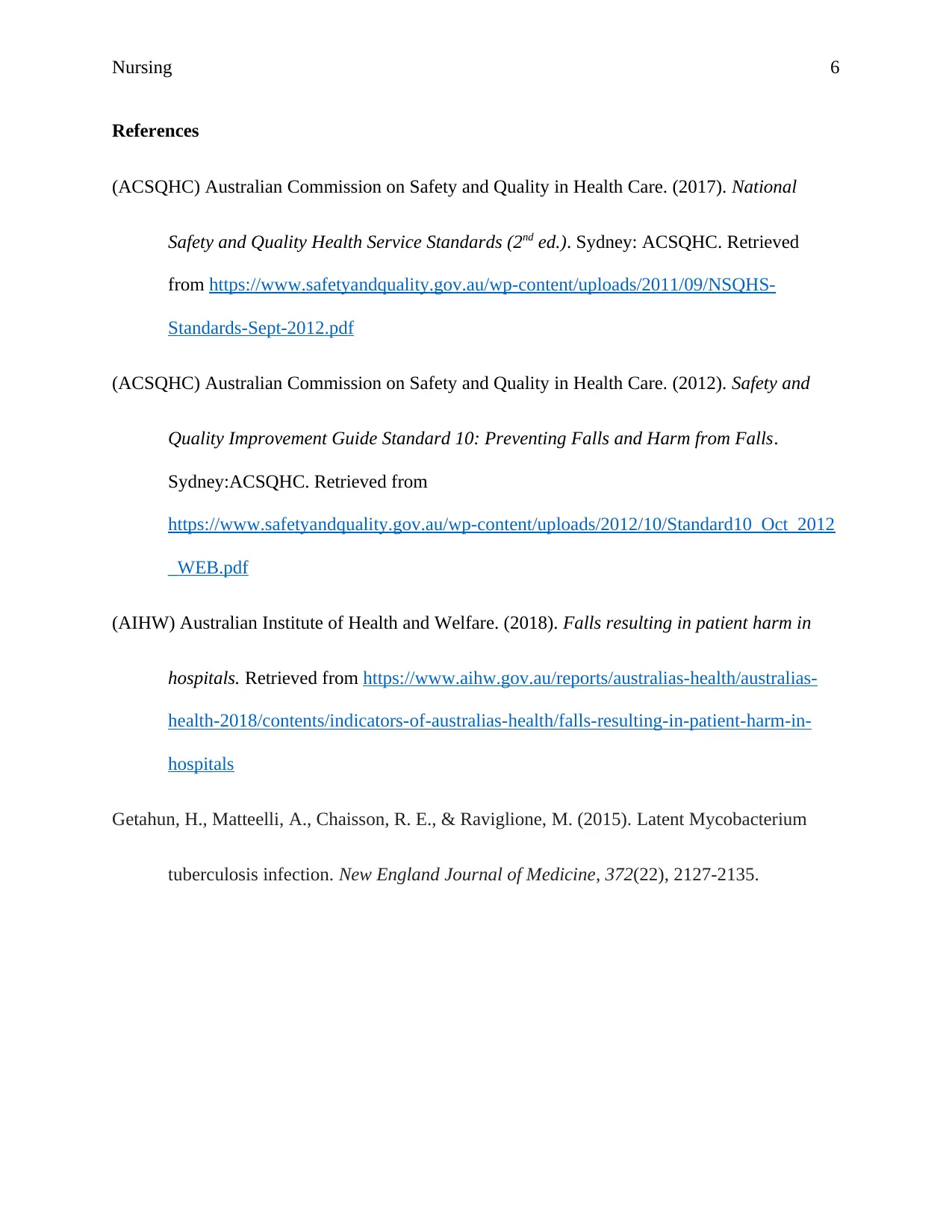
Nursing 6
References
(ACSQHC) Australian Commission on Safety and Quality in Health Care. (2017). National
Safety and Quality Health Service Standards (2nd ed.). Sydney: ACSQHC. Retrieved
from https://www.safetyandquality.gov.au/wp-content/uploads/2011/09/NSQHS-
Standards-Sept-2012.pdf
(ACSQHC) Australian Commission on Safety and Quality in Health Care. (2012). Safety and
Quality Improvement Guide Standard 10: Preventing Falls and Harm from Falls.
Sydney:ACSQHC. Retrieved from
https://www.safetyandquality.gov.au/wp-content/uploads/2012/10/Standard10_Oct_2012
_WEB.pdf
(AIHW) Australian Institute of Health and Welfare. (2018). Falls resulting in patient harm in
hospitals. Retrieved from https://www.aihw.gov.au/reports/australias-health/australias-
health-2018/contents/indicators-of-australias-health/falls-resulting-in-patient-harm-in-
hospitals
Getahun, H., Matteelli, A., Chaisson, R. E., & Raviglione, M. (2015). Latent Mycobacterium
tuberculosis infection. New England Journal of Medicine, 372(22), 2127-2135.
References
(ACSQHC) Australian Commission on Safety and Quality in Health Care. (2017). National
Safety and Quality Health Service Standards (2nd ed.). Sydney: ACSQHC. Retrieved
from https://www.safetyandquality.gov.au/wp-content/uploads/2011/09/NSQHS-
Standards-Sept-2012.pdf
(ACSQHC) Australian Commission on Safety and Quality in Health Care. (2012). Safety and
Quality Improvement Guide Standard 10: Preventing Falls and Harm from Falls.
Sydney:ACSQHC. Retrieved from
https://www.safetyandquality.gov.au/wp-content/uploads/2012/10/Standard10_Oct_2012
_WEB.pdf
(AIHW) Australian Institute of Health and Welfare. (2018). Falls resulting in patient harm in
hospitals. Retrieved from https://www.aihw.gov.au/reports/australias-health/australias-
health-2018/contents/indicators-of-australias-health/falls-resulting-in-patient-harm-in-
hospitals
Getahun, H., Matteelli, A., Chaisson, R. E., & Raviglione, M. (2015). Latent Mycobacterium
tuberculosis infection. New England Journal of Medicine, 372(22), 2127-2135.
⊘ This is a preview!⊘
Do you want full access?
Subscribe today to unlock all pages.

Trusted by 1+ million students worldwide
1 out of 6
Related Documents
Your All-in-One AI-Powered Toolkit for Academic Success.
+13062052269
info@desklib.com
Available 24*7 on WhatsApp / Email
![[object Object]](/_next/static/media/star-bottom.7253800d.svg)
Unlock your academic potential
Copyright © 2020–2025 A2Z Services. All Rights Reserved. Developed and managed by ZUCOL.




